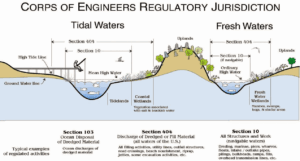The Clean Water Act (CWA) defines “waters of the United States” as it applies to the jurisdictional limits of the authority of the Army Corps of Engineers (Corps). It stipulates the policy, practices, and procedures to be used in determining the extent of jurisdiction of the Corps concerning “waters of the United States.”
“Waters of the United States” in CWA’s Section 404 are as follows…
- All waters that are currently used, or were used in the past, or may be susceptible to use in interstate or foreign commerce, including all waters that are subject to the ebb and flow of the tide.
- All interstate waters, including interstate wetlands.
- All other waters, such as intrastate lakes, rivers, streams (including intermittent streams), mudflats, sand flats, wetlands, sloughs, prairie potholes, wet meadows, Playa lakes, or natural ponds, the use, degradation, or destruction of which could affect interstate or foreign commerce, including any waters:
- That are or could be used by interstate or foreign travelers for recreational or other purposes;
- From which fish or shellfish are or could be taken and sold in interstate or foreign commerce; or
- That are or could be used for industrial purposes by industries in interstate commerce.
- All impoundments of waters otherwise defined as waters of the United States under the definition.
- Tributaries of previously listed waters.
- The territorial seas.
- Wetlands adjacent to previously listed waters.
What Does “Adjacent to Previously Listed Waters” Mean?
The term “adjacent” means bordering, contiguous, or neighboring. Wetlands separated from other waters of the United States by man-made dikes or barriers, natural river berms, beach dunes, and the like are “adjacent wetlands.” The U.S. Supreme Court has developed two tests to determine whether the Corps and EPA would have jurisdiction over certain waters that do not fall in the clear jurisdiction category of traditional navigable waters.
Two Jurisdiction Tests
- Are the wetlands both adjacent to, and have a continuous surface connection with, a relatively permanent body of water connected to traditional interstate navigable waters?
- The “significant nexus” test, focuses on the relationship between the ecological characteristics of tributaries and those of their adjacent wetlands, which may determine their contribution to restoring and maintaining the chemical, physical, and biological integrity of U.S. traditional navigable waters. For purposes of determining jurisdiction, a wetland is “adjacent” if it has an unbroken hydrologic connection to jurisdictional waters, is separated from those waters by a berm or similar feature, or it is in reasonably close proximity to a jurisdictional water. The significant nexus analysis is applied on a case-by-case basis.
- The first test limits jurisdiction to situations where wetlands are both adjacent to, and has a continuous surface connection with, a relatively permanent body of water connected to traditional interstate navigable waters.
- If the tributary does have adjacent wetlands, the agencies will examine the flow and functions of the tributary along with the functions performed by the adjacent wetlands to evaluate whether a significant nexus exists. If it is determined that a tributary and its adjacent wetlands together have a significant nexus with traditional navigable waters and the effect of the tributary and adjacent wetlands is more than speculative or insubstantial, the tributary and its adjacent wetlands fall under the jurisdiction of the CWA.

